Abstract
1. Neurons from a horizontal slice of adult rat brainstem were examined using intracellular recording techniques. Investigations were restricted to a region within the nucleus tractus solitarii, medial to the solitary tract and centred on the obex (mNTS). Previous work has shown this restricted area of the NTS to contain the greatest concentration of aortic afferent baroreceptor terminal fields. Electrical stimulation of the tract elicited short-latency excitatory postsynaptic potentials in all neurons. 2. mNTS neurons were spontaneously active with firing frequencies ranging between 1 and 10 Hz, at resting potentials of -65 to -45 mV. These neurons did not exhibit spontaneous bursting activity. 3. Depolarizing current injection immediately evoked a finite, high-frequency spike discharge which rapidly declined to a lower steady-state level (i.e. spike frequency adaptation, SFA). Increasing depolarizations produced a marked increase in the peak instantaneous frequency but a much smaller increase in the steady-state firing level. 4. Conditioning with a hyperpolarizing prepulse resulted in a prolonged delay of up to 600 ms before the first action potential (i.e. delayed excitation, DE) with an attendant decrease in peak discharge rates. DE was modulated by both the magnitude and duration of the prestimulus hyperpolarization, as well as the magnitude of the depolarizing stimulus. Tetrodotoxin (TTX) eliminated spike discharge but had little effect on the ramp-like membrane depolarization characteristic of DE. 5. We have developed a mathematical model for mNTS neurons to facilitate our understanding of the interplay between the underlying ionic currents. It consists of a comprehensive membrane model of the Hodgkin-Huxley type coupled with a fluid compartment model describing cytoplasmic [Ca2+]i homeostasis. 6. The model suggests that (a) SFA is caused by an increase in [Ca2+]i which activates the outward K+ current, IK,Ca, and (b) DE results from the competitive interaction between the injected depolarizing current and the hyperpolarization-activated transient outward K+ currents, IA and ID. 7. We conclude that our ionic current model is capable of providing biophysical explanations for a number of phenomena associated with brainstem neurons, either during spontaneous activity or in response to patterned injections of current. This model is a potentially useful adjunct for on-going research into the central mechanisms involved in the regulation of both blood pressure and ventilation.
Full text
PDF






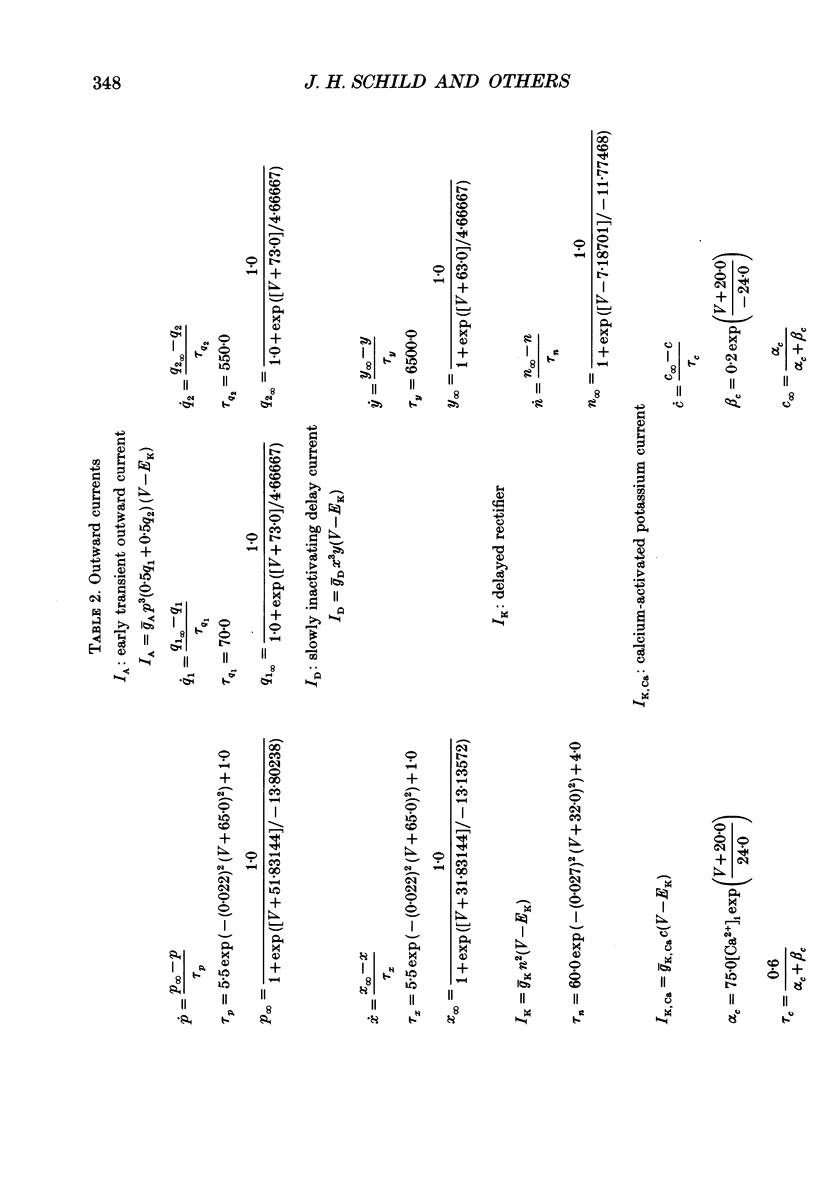


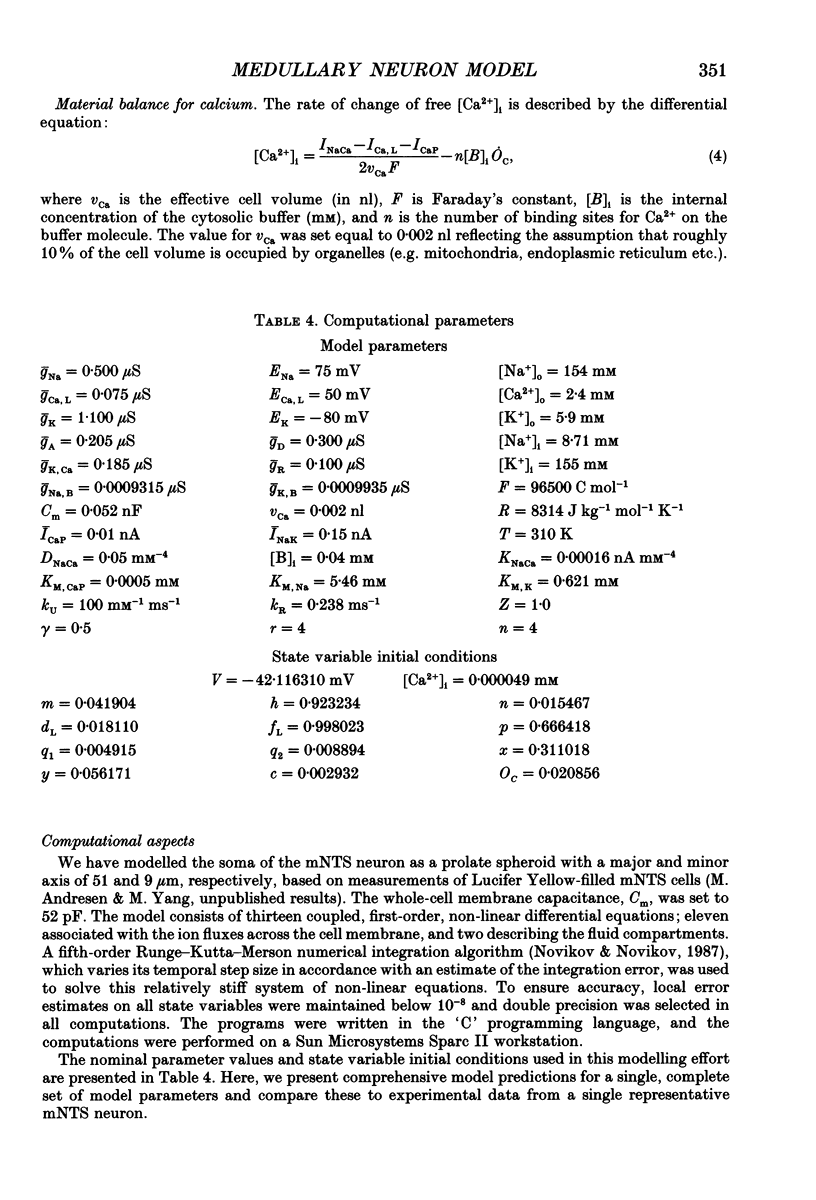



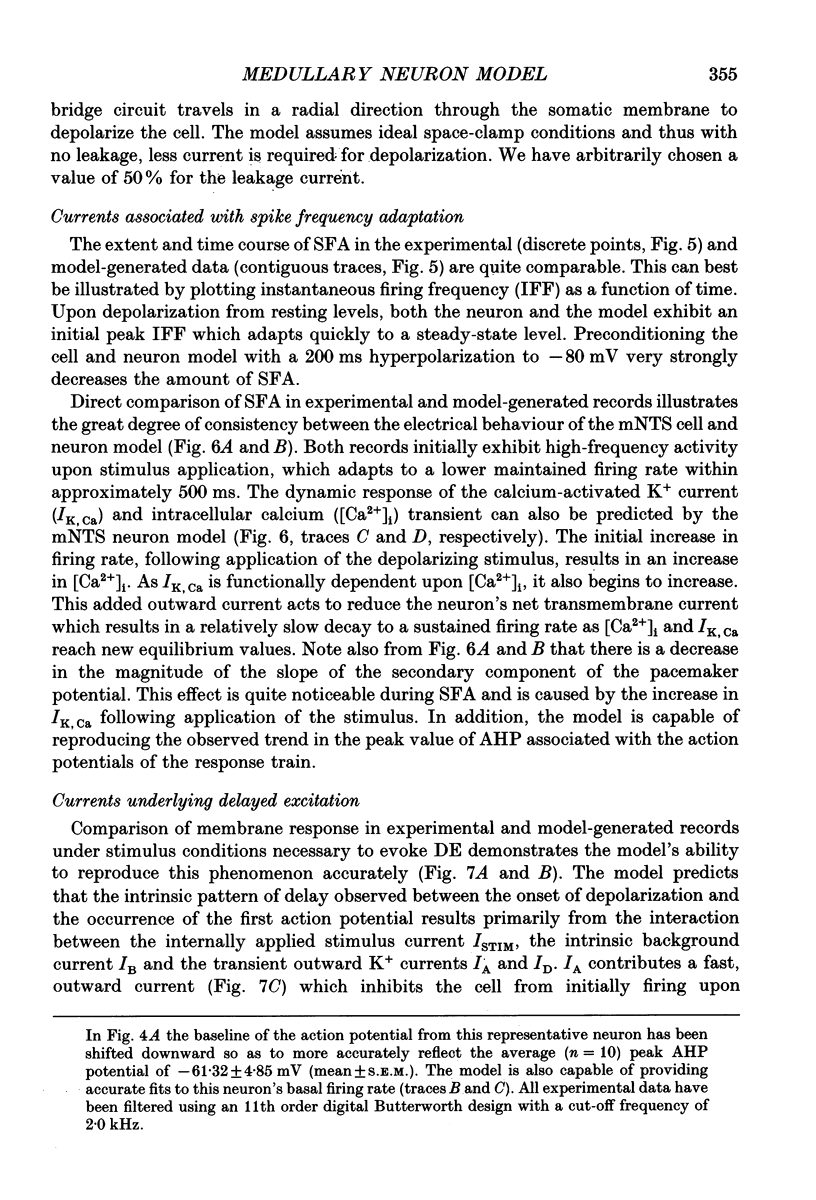



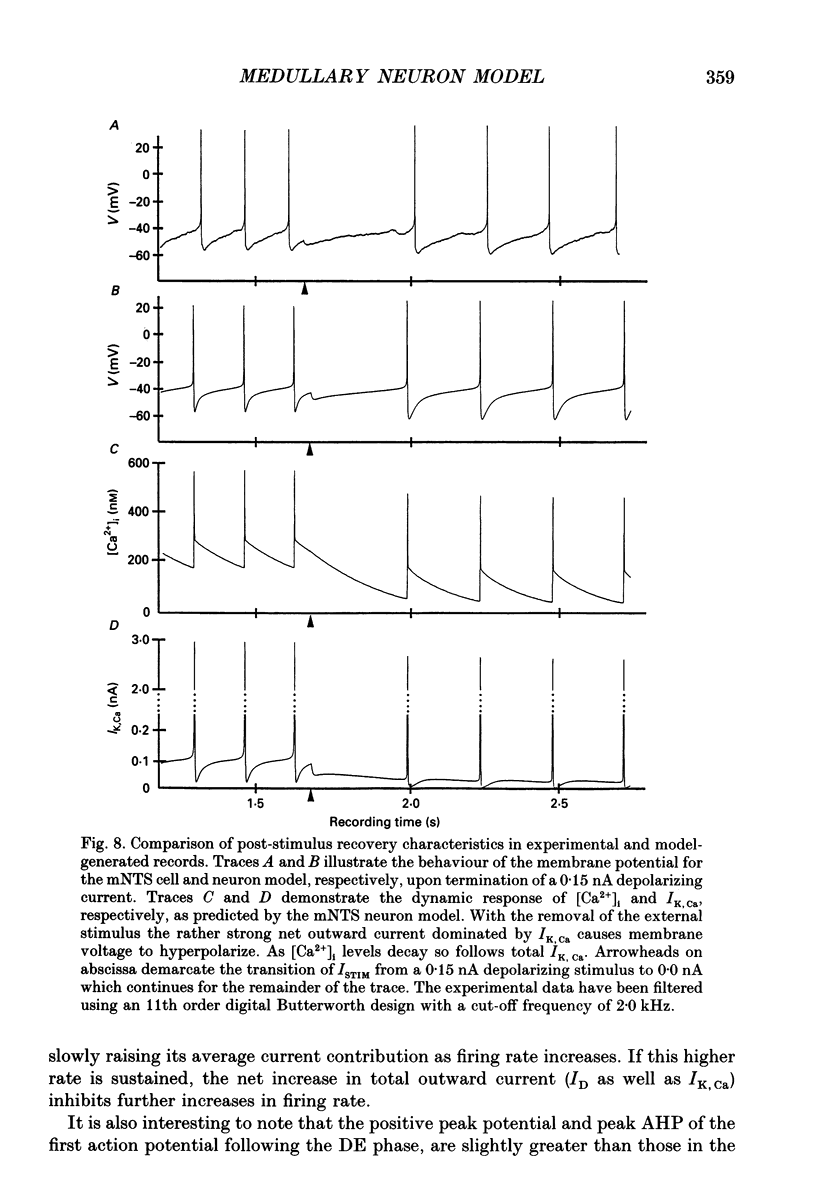



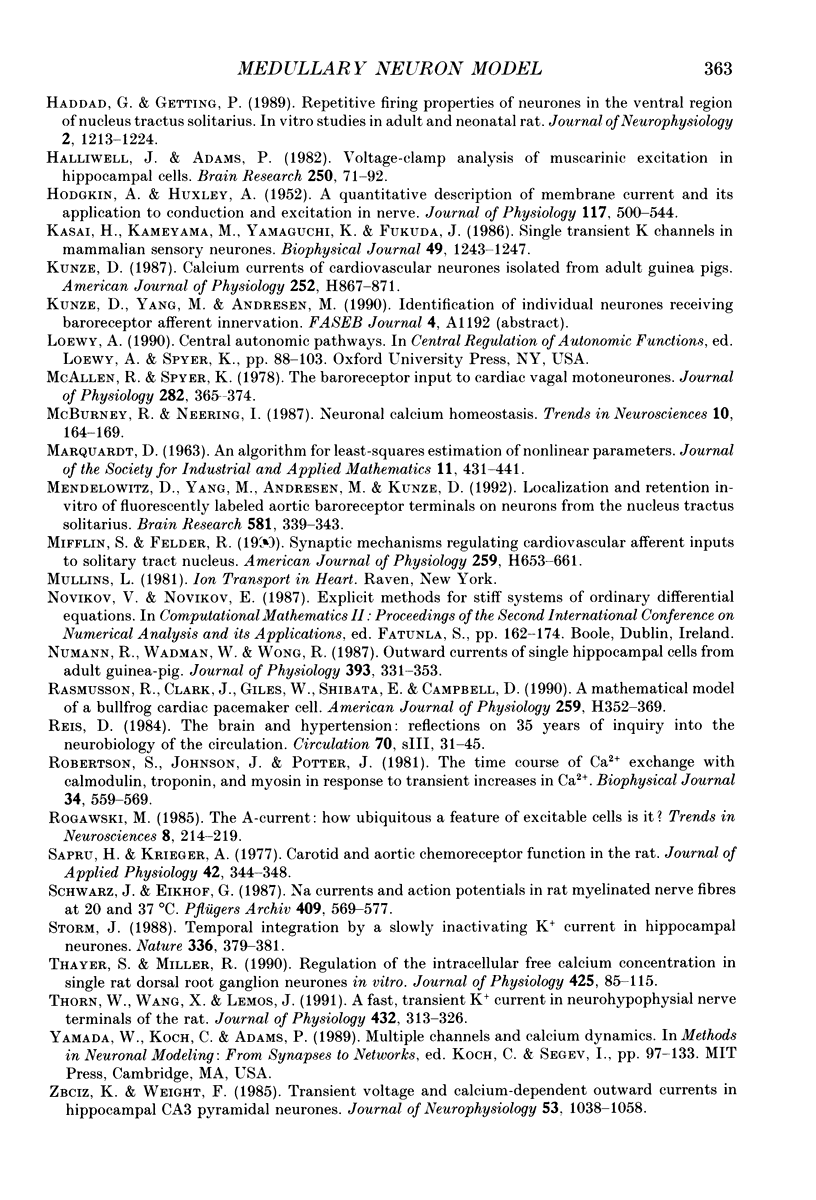
Selected References
These references are in PubMed. This may not be the complete list of references from this article.
- Andresen M. C., Yang M. Y. Non-NMDA receptors mediate sensory afferent synaptic transmission in medial nucleus tractus solitarius. Am J Physiol. 1990 Oct;259(4 Pt 2):H1307–H1311. doi: 10.1152/ajpheart.1990.259.4.H1307. [DOI] [PubMed] [Google Scholar]
- Belluzzi O., Sacchi O. A five-conductance model of the action potential in the rat sympathetic neurone. Prog Biophys Mol Biol. 1991;55(1):1–30. doi: 10.1016/0079-6107(91)90009-h. [DOI] [PubMed] [Google Scholar]
- Belluzzi O., Sacchi O. Calcium currents in the normal adult rat sympathetic neurone. J Physiol. 1989 May;412:493–512. doi: 10.1113/jphysiol.1989.sp017628. [DOI] [PMC free article] [PubMed] [Google Scholar]
- Bradley R. M., Sweazey R. D. Separation of neuron types in the gustatory zone of the nucleus tractus solitarii on the basis of intrinsic firing properties. J Neurophysiol. 1992 Jun;67(6):1659–1668. doi: 10.1152/jn.1992.67.6.1659. [DOI] [PubMed] [Google Scholar]
- Brown D. A., Gähwiler B. H., Griffith W. H., Halliwell J. V. Membrane currents in hippocampal neurons. Prog Brain Res. 1990;83:141–160. doi: 10.1016/s0079-6123(08)61247-9. [DOI] [PubMed] [Google Scholar]
- Canavier C. C., Clark J. W., Byrne J. H. Simulation of the bursting activity of neuron R15 in Aplysia: role of ionic currents, calcium balance, and modulatory transmitters. J Neurophysiol. 1991 Dec;66(6):2107–2124. doi: 10.1152/jn.1991.66.6.2107. [DOI] [PubMed] [Google Scholar]
- Caroni P., Zurini M., Clark A., Carafoli E. Further characterization and reconstitution of the purified Ca2+-pumping ATPase of heart sarcolemma. J Biol Chem. 1983 Jun 25;258(12):7305–7310. [PubMed] [Google Scholar]
- Champagnat J., Jacquin T., Richter D. W. Voltage-dependent currents in neurones of the nuclei of the solitary tract of rat brainstem slices. Pflugers Arch. 1986 Apr;406(4):372–379. doi: 10.1007/BF00590939. [DOI] [PubMed] [Google Scholar]
- Ciriello J. Brainstem projections of aortic baroreceptor afferent fibers in the rat. Neurosci Lett. 1983 Mar 28;36(1):37–42. doi: 10.1016/0304-3940(83)90482-2. [DOI] [PubMed] [Google Scholar]
- Dekin M. S., Getting P. A. In vitro characterization of neurons in the ventral part of the nucleus tractus solitarius. II. Ionic basis for repetitive firing patterns. J Neurophysiol. 1987 Jul;58(1):215–229. doi: 10.1152/jn.1987.58.1.215. [DOI] [PubMed] [Google Scholar]
- Dekin M. S., Getting P. A., Johnson S. M. In vitro characterization of neurons in the ventral part of the nucleus tractus solitarius. I. Identification of neuronal types and repetitive firing properties. J Neurophysiol. 1987 Jul;58(1):195–214. doi: 10.1152/jn.1987.58.1.195. [DOI] [PubMed] [Google Scholar]
- Dekin M. S., Haddad G. G. Membrane and cellular properties in oscillating networks: implications for respiration. J Appl Physiol (1985) 1990 Sep;69(3):809–821. doi: 10.1152/jappl.1990.69.3.809. [DOI] [PubMed] [Google Scholar]
- DiFrancesco D., Noble D. A model of cardiac electrical activity incorporating ionic pumps and concentration changes. Philos Trans R Soc Lond B Biol Sci. 1985 Jan 10;307(1133):353–398. doi: 10.1098/rstb.1985.0001. [DOI] [PubMed] [Google Scholar]
- Greene R. W., Haas H. L., Reiner P. B. Two transient outward currents in histamine neurones of the rat hypothalamus in vitro. J Physiol. 1990 Jan;420:149–163. doi: 10.1113/jphysiol.1990.sp017905. [DOI] [PMC free article] [PubMed] [Google Scholar]
- HODGKIN A. L., HUXLEY A. F. A quantitative description of membrane current and its application to conduction and excitation in nerve. J Physiol. 1952 Aug;117(4):500–544. doi: 10.1113/jphysiol.1952.sp004764. [DOI] [PMC free article] [PubMed] [Google Scholar]
- Haddad G. G., Getting P. A. Repetitive firing properties of neurons in the ventral region of nucleus tractus solitarius. In vitro studies in adult and neonatal rat. J Neurophysiol. 1989 Dec;62(6):1213–1224. doi: 10.1152/jn.1989.62.6.1213. [DOI] [PubMed] [Google Scholar]
- Halliwell J. V., Adams P. R. Voltage-clamp analysis of muscarinic excitation in hippocampal neurons. Brain Res. 1982 Oct 28;250(1):71–92. doi: 10.1016/0006-8993(82)90954-4. [DOI] [PubMed] [Google Scholar]
- Kasai H., Kameyama M., Yamaguchi K., Fukuda J. Single transient K channels in mammalian sensory neurons. Biophys J. 1986 Jun;49(6):1243–1247. doi: 10.1016/S0006-3495(86)83754-7. [DOI] [PMC free article] [PubMed] [Google Scholar]
- Kunze D. L. Calcium currents of cardiovascular neurons isolated from adult guinea pigs. Am J Physiol. 1987 Apr;252(4 Pt 2):H867–H871. doi: 10.1152/ajpheart.1987.252.4.H867. [DOI] [PubMed] [Google Scholar]
- McAllen R. M., Spyer K. M. The baroreceptor input to cardiac vagal motoneurones. J Physiol. 1978 Sep;282:365–374. doi: 10.1113/jphysiol.1978.sp012469. [DOI] [PMC free article] [PubMed] [Google Scholar]
- Mendelowitz D., Yang M., Andresen M. C., Kunze D. L. Localization and retention in vitro of fluorescently labeled aortic baroreceptor terminals on neurons from the nucleus tractus solitarius. Brain Res. 1992 May 29;581(2):339–343. doi: 10.1016/0006-8993(92)90729-s. [DOI] [PubMed] [Google Scholar]
- Mifflin S. W., Felder R. B. Synaptic mechanisms regulating cardiovascular afferent inputs to solitary tract nucleus. Am J Physiol. 1990 Sep;259(3 Pt 2):H653–H661. doi: 10.1152/ajpheart.1990.259.3.H653. [DOI] [PubMed] [Google Scholar]
- Numann R. E., Wadman W. J., Wong R. K. Outward currents of single hippocampal cells obtained from the adult guinea-pig. J Physiol. 1987 Dec;393:331–353. doi: 10.1113/jphysiol.1987.sp016826. [DOI] [PMC free article] [PubMed] [Google Scholar]
- Rasmusson R. L., Clark J. W., Giles W. R., Shibata E. F., Campbell D. L. A mathematical model of a bullfrog cardiac pacemaker cell. Am J Physiol. 1990 Aug;259(2 Pt 2):H352–H369. doi: 10.1152/ajpheart.1990.259.2.H352. [DOI] [PubMed] [Google Scholar]
- Robertson S. P., Johnson J. D., Potter J. D. The time-course of Ca2+ exchange with calmodulin, troponin, parvalbumin, and myosin in response to transient increases in Ca2+. Biophys J. 1981 Jun;34(3):559–569. doi: 10.1016/S0006-3495(81)84868-0. [DOI] [PMC free article] [PubMed] [Google Scholar]
- Sapru H. N., Krieger A. J. Carotid and aortic chemoreceptor function in the rat. J Appl Physiol Respir Environ Exerc Physiol. 1977 Mar;42(3):344–348. doi: 10.1152/jappl.1977.42.3.344. [DOI] [PubMed] [Google Scholar]
- Schwarz J. R., Eikhof G. Na currents and action potentials in rat myelinated nerve fibres at 20 and 37 degrees C. Pflugers Arch. 1987 Aug;409(6):569–577. doi: 10.1007/BF00584655. [DOI] [PubMed] [Google Scholar]
- Storm J. F. Temporal integration by a slowly inactivating K+ current in hippocampal neurons. Nature. 1988 Nov 24;336(6197):379–381. doi: 10.1038/336379a0. [DOI] [PubMed] [Google Scholar]
- Thayer S. A., Miller R. J. Regulation of the intracellular free calcium concentration in single rat dorsal root ganglion neurones in vitro. J Physiol. 1990 Jun;425:85–115. doi: 10.1113/jphysiol.1990.sp018094. [DOI] [PMC free article] [PubMed] [Google Scholar]
- Thorn P. J., Wang X. M., Lemos J. R. A fast, transient K+ current in neurohypophysial nerve terminals of the rat. J Physiol. 1991 Jan;432:313–326. doi: 10.1113/jphysiol.1991.sp018386. [DOI] [PMC free article] [PubMed] [Google Scholar]
- Zbicz K. L., Weight F. F. Transient voltage and calcium-dependent outward currents in hippocampal CA3 pyramidal neurons. J Neurophysiol. 1985 Apr;53(4):1038–1058. doi: 10.1152/jn.1985.53.4.1038. [DOI] [PubMed] [Google Scholar]


